Still have questions? Leave a comment

Checklist: Dissertation Proposal
Enter your email id to get the downloadable right in your inbox!

Examples: Edited Papers
Enter your email id to get the downloadable right in your inbox!
Need
Editing and
Proofreading Services?

What Is an Adjective? Definition, Usage & Examples
 May 05, 2025
May 05, 2025 9
min read
9
min read
Have you ever struggled to find the right words to describe something? This is where adjectives can help! In this article, we’ve explained everything- from the adjective meaning to its types and usage.
Unlike in other languages, English has specific guidelines for arranging adjectives within sentences, which is crucial for clarity and correctness.
Browse through all the examples of adjectives given to understand them better! We’ve also clarified the meaning of adjective forms. With this, we’ve demonstrated their usage through examples. So without further delay, let’s jump into the details!
We’ll quickly define adjectives before moving on to the forms.
What is an adjective?
An adjective is a word that describes or gives more information about a noun or pronoun in a sentence. Adjectives can be used to highlight the qualities of a person, thing, animal, or place.
Let’s see some examples to understand this adjective definition:
I bought a big box of chocolates.
He said that she looked beautiful.
They gave him an amazing surprise.
The above examples accurately demonstrate what are adjectives. Interestingly, the word “adjective” has a unique history that dates back to the Middle Ages.

After understanding the basics of adjectives, let’s understand adjective forms in detail.
Adjective forms
There are 3 types of adjective forms: absolute, comparative, and superlative. The following table explains these 3 forms:
To understand these adjective forms better, let’s see examples of adjective forms in sentences.
Examples of adjective forms
I got a big box of chocolates. (Absolute adjective)
The box I got was bigger than your box of chocolates. (Comparative adjective)
I got the biggest box of chocolates. (Superlative adjective)
Ben is a smart person. (Absolute adjective)
Mark is smarter than Ben. (Comparative adjective)
Out of Ben, Mark, and John, John is the smartest. (Superlative adjective)
Now let’s understand the different types of adjectives in detail!
Types of adjectives
1. Possessive adjectives
Adjectives showing ownership and possession, indicating that something belongs to someone are possessive adjectives. His, her, my, yours, ours, theirs are some examples of possessive adjectives. Let us see how these adjectives can be used in sentences.
I took his pen.
This is my watch.
That bungalow is ours.
2. Demonstrative adjectives
Demonstrative adjectives point out specific nouns within a sentence. This, that, these, and those are some examples of demonstrative adjectives. The following are some sentences that show their usage.
This is my book.
These apples are fresh.
That is my drawing.
3. Interrogative adjectives
Adjectives that are used to ask a question are known as interrogative adjectives. What, which, whose, where, and how are some examples of interrogative adjectives. The sentences given below accurately demonstrate their usage.
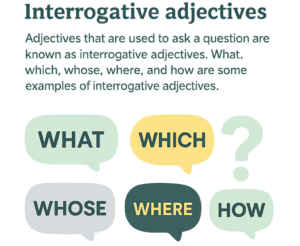
What is the time?
Where is the Atlantic Ocean?
How is your health?
4. Numerical Adjectives
Numerical adjectives are those that depict a specific number of nouns. First, second, third, fourth, fortieth, and fiftieth are some examples of numerical adjectives.
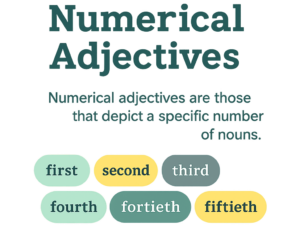
Here are some sentences that illustrate their usage:
He came fourth in the race.
It was her fortieth birthday.
She came first in class.
5. Participial adjectives
Adjectives that are similar to a verb’s participle form (ending with ‘ed’ or ‘ing’) are known as participial adjectives. A past participle usually ends in -ed and describes subjects affected by an action. Some examples with participial adjectives are.
The excited fans cheered their favorite team.
The sleeping baby looked peaceful in her crib.
The singing birds created a delightful melody.
6. Compound adjectives
Compound adjectives are those adjectives that are formed by combining two words. Usually, a hyphen is added between the two words.
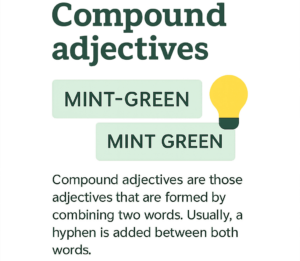
Here are some examples of compound adjectives:
John is a detail-oriented employee.
I know a store that sells eco-friendly products.
It was a time-consuming process.
7. Denominal adjectives
Adjectives that are formed by adding suffixes like “ish”, “ly”, and “al” to nouns are called denominal adjectives. Financial, cowardly, bookish, boyish, and musical are some examples of denominal adjectives. The following sentences explain how to use denominal adjectives:
Ben manufactured industrial products.
He was fired for his clownish behavior.
She loved their friendly gesture.
8. Nominal adjectives
Nominal adjectives are those adjectives that play the role of nouns in a sentence. Usually, the word “the” is written before the nominal adjectives. Read the sentences given below to understand nominal adjectives.
Amy founded an organization for the blind.
She took care of the elderly.
The rich can manipulate situations to achieve their goals.
9. Appositive adjectives
Appositive adjectives are those adjectives that are usually written after the noun they modify and are separated by commas or dashes. The following examples demonstrate how to use appositive adjectives in sentences:
My sister, a hardworking and intelligent student, won the Maths Olympiad.
The sea, stormy and turbulent, was visible now.
The lighthouse, tall and bright, helped to warn many about danger.
10. Indefinite adjectives
Indefinite adjectives describe those nouns whose exact quantity/number isn’t mentioned. Some, any, many, few, and several are examples of indefinite adjectives.
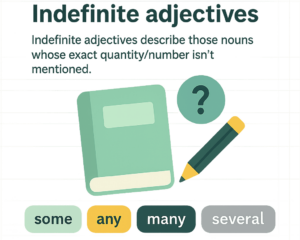
To understand how to utilize these adjectives, read the following sentences:
I ate some apples.
There are many job opportunities in India.
She knows a few influencers.
11. Cumulative adjectives
Cumulative adjectives are two or more adjectives that give information about the same noun. Coordinate adjectives are two or more adjectives modifying the same noun and can be separated by commas or the conjunction ‘and’. The examples given below explain the usage of cumulative adjectives:
She wore a bright yellow dress.
The old, rusty car finally got a new look.
I loved the cozy, warm room with the splendid balcony.
12. Predicate adjectives
The adjectives that provide more information about the sentence’s subject are known as predicate adjectives. Usually, they are connected to the sentence using verbs. For better clarity, read the following examples!
The coffee was cold.
I gave him a strong reply.
She realized that she felt terrible.
13. Descriptive adjectives
An adjective that describes the quality of a noun is a descriptive adjective. Beautiful, scenic, sweet, and dramatic are some examples of descriptive adjectives. The following sentences explain how to use descriptive adjectives:
She bought a blue purse.
They gave him a wonderful surprise.
We went to an amazing hotel.
14. Proper adjectives
Proper adjectives are those that are derived from proper nouns. They are often derived from proper nouns, including nationalities and languages. Indian, Marxist, Shakespearean, and Freudian are some examples of proper adjectives.
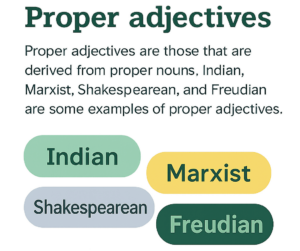
Here are some examples that clarify the usage of proper adjectives:
The American soldier was given a secret task.
He was a strong believer in Darwinian theories.
She loved the architecture of Victorian times.
Often, many have confusion between adjective words and one of the most important parts of speech– adverbs. Let’s clear this confusion once and for all!
Adjectives vs. Adverbs: What’s the difference?
The difference between adjectives and adverbs is that while adjectives describe nouns, adverbs give more information about the verbs in the sentence. Adverbs modify verbs, adjectives, and other adverbs, while adjectives exclusively modify nouns.
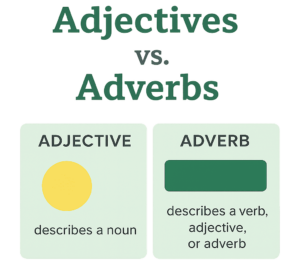
The following adjective vs. adverb examples make this clearer:
He ran quickly to win the race. (Quickly describes the verb ran)
She participated in an amazing race. (Amazing describes the noun race)
They reacted immediately to the announcement. (Immediately describes the verb reacted)
These adverb and adjective examples clarify the difference between adjectives and adverbs. However, there is more about adjectives that you need to know. Let’s see adjectives that are commonly used. Whether you want adjectives to describe yourself or others, this list will help!
A comprehensive list of adjectives
You can use the above adjectives to describe a person, thing, animal, or place. After understanding the definition of adjectives and their types, you can construct sentences using them. While structuring sentences, it’s also important to proofread and check grammar for clear communication.
At PaperTrue, we provide expert editing and proofreading services for students, businesses, researchers, and authors. Whether you want to edit a research paper, essay, dissertation, journal article, or business paper, we can help!
Here are some articles that you might find interesting:






